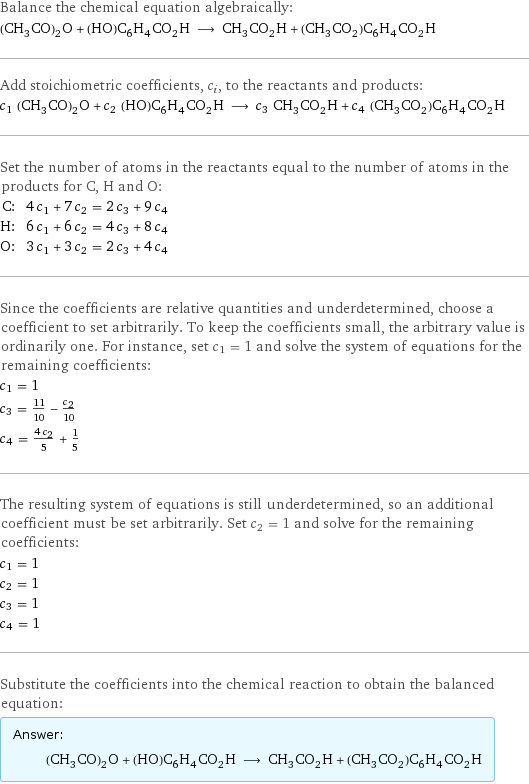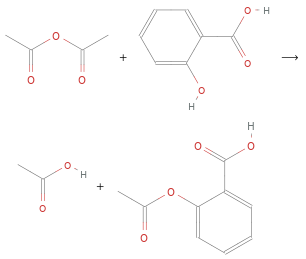Input interpretation

(CH_3CO)_2O acetic anhydride + (HO)C_6H_4CO_2H salicylic acid ⟶ CH_3CO_2H acetic acid + (CH_3CO_2)C_6H_4CO_2H aspirin
Balanced equation

Balance the chemical equation algebraically: (CH_3CO)_2O + (HO)C_6H_4CO_2H ⟶ CH_3CO_2H + (CH_3CO_2)C_6H_4CO_2H Add stoichiometric coefficients, c_i, to the reactants and products: c_1 (CH_3CO)_2O + c_2 (HO)C_6H_4CO_2H ⟶ c_3 CH_3CO_2H + c_4 (CH_3CO_2)C_6H_4CO_2H Set the number of atoms in the reactants equal to the number of atoms in the products for C, H and O: C: | 4 c_1 + 7 c_2 = 2 c_3 + 9 c_4 H: | 6 c_1 + 6 c_2 = 4 c_3 + 8 c_4 O: | 3 c_1 + 3 c_2 = 2 c_3 + 4 c_4 Since the coefficients are relative quantities and underdetermined, choose a coefficient to set arbitrarily. To keep the coefficients small, the arbitrary value is ordinarily one. For instance, set c_1 = 1 and solve the system of equations for the remaining coefficients: c_1 = 1 c_3 = 11/10 - c_2/10 c_4 = (4 c_2)/5 + 1/5 The resulting system of equations is still underdetermined, so an additional coefficient must be set arbitrarily. Set c_2 = 1 and solve for the remaining coefficients: c_1 = 1 c_2 = 1 c_3 = 1 c_4 = 1 Substitute the coefficients into the chemical reaction to obtain the balanced equation: Answer: | | (CH_3CO)_2O + (HO)C_6H_4CO_2H ⟶ CH_3CO_2H + (CH_3CO_2)C_6H_4CO_2H
Structures

+ ⟶ +
Names

acetic anhydride + salicylic acid ⟶ acetic acid + aspirin
Equilibrium constant
![Construct the equilibrium constant, K, expression for: (CH_3CO)_2O + (HO)C_6H_4CO_2H ⟶ CH_3CO_2H + (CH_3CO_2)C_6H_4CO_2H Plan: • Balance the chemical equation. • Determine the stoichiometric numbers. • Assemble the activity expression for each chemical species. • Use the activity expressions to build the equilibrium constant expression. Write the balanced chemical equation: (CH_3CO)_2O + (HO)C_6H_4CO_2H ⟶ CH_3CO_2H + (CH_3CO_2)C_6H_4CO_2H Assign stoichiometric numbers, ν_i, using the stoichiometric coefficients, c_i, from the balanced chemical equation in the following manner: ν_i = -c_i for reactants and ν_i = c_i for products: chemical species | c_i | ν_i (CH_3CO)_2O | 1 | -1 (HO)C_6H_4CO_2H | 1 | -1 CH_3CO_2H | 1 | 1 (CH_3CO_2)C_6H_4CO_2H | 1 | 1 Assemble the activity expressions accounting for the state of matter and ν_i: chemical species | c_i | ν_i | activity expression (CH_3CO)_2O | 1 | -1 | ([(CH3CO)2O])^(-1) (HO)C_6H_4CO_2H | 1 | -1 | ([(HO)C6H4CO2H])^(-1) CH_3CO_2H | 1 | 1 | [CH3CO2H] (CH_3CO_2)C_6H_4CO_2H | 1 | 1 | [(CH3CO2)C6H4CO2H] The equilibrium constant symbol in the concentration basis is: K_c Mulitply the activity expressions to arrive at the K_c expression: Answer: | | K_c = ([(CH3CO)2O])^(-1) ([(HO)C6H4CO2H])^(-1) [CH3CO2H] [(CH3CO2)C6H4CO2H] = ([CH3CO2H] [(CH3CO2)C6H4CO2H])/([(CH3CO)2O] [(HO)C6H4CO2H])](../image_source/d63ac6dd4b9274a3bf477bb3b415d494.png)
Construct the equilibrium constant, K, expression for: (CH_3CO)_2O + (HO)C_6H_4CO_2H ⟶ CH_3CO_2H + (CH_3CO_2)C_6H_4CO_2H Plan: • Balance the chemical equation. • Determine the stoichiometric numbers. • Assemble the activity expression for each chemical species. • Use the activity expressions to build the equilibrium constant expression. Write the balanced chemical equation: (CH_3CO)_2O + (HO)C_6H_4CO_2H ⟶ CH_3CO_2H + (CH_3CO_2)C_6H_4CO_2H Assign stoichiometric numbers, ν_i, using the stoichiometric coefficients, c_i, from the balanced chemical equation in the following manner: ν_i = -c_i for reactants and ν_i = c_i for products: chemical species | c_i | ν_i (CH_3CO)_2O | 1 | -1 (HO)C_6H_4CO_2H | 1 | -1 CH_3CO_2H | 1 | 1 (CH_3CO_2)C_6H_4CO_2H | 1 | 1 Assemble the activity expressions accounting for the state of matter and ν_i: chemical species | c_i | ν_i | activity expression (CH_3CO)_2O | 1 | -1 | ([(CH3CO)2O])^(-1) (HO)C_6H_4CO_2H | 1 | -1 | ([(HO)C6H4CO2H])^(-1) CH_3CO_2H | 1 | 1 | [CH3CO2H] (CH_3CO_2)C_6H_4CO_2H | 1 | 1 | [(CH3CO2)C6H4CO2H] The equilibrium constant symbol in the concentration basis is: K_c Mulitply the activity expressions to arrive at the K_c expression: Answer: | | K_c = ([(CH3CO)2O])^(-1) ([(HO)C6H4CO2H])^(-1) [CH3CO2H] [(CH3CO2)C6H4CO2H] = ([CH3CO2H] [(CH3CO2)C6H4CO2H])/([(CH3CO)2O] [(HO)C6H4CO2H])
Rate of reaction
![Construct the rate of reaction expression for: (CH_3CO)_2O + (HO)C_6H_4CO_2H ⟶ CH_3CO_2H + (CH_3CO_2)C_6H_4CO_2H Plan: • Balance the chemical equation. • Determine the stoichiometric numbers. • Assemble the rate term for each chemical species. • Write the rate of reaction expression. Write the balanced chemical equation: (CH_3CO)_2O + (HO)C_6H_4CO_2H ⟶ CH_3CO_2H + (CH_3CO_2)C_6H_4CO_2H Assign stoichiometric numbers, ν_i, using the stoichiometric coefficients, c_i, from the balanced chemical equation in the following manner: ν_i = -c_i for reactants and ν_i = c_i for products: chemical species | c_i | ν_i (CH_3CO)_2O | 1 | -1 (HO)C_6H_4CO_2H | 1 | -1 CH_3CO_2H | 1 | 1 (CH_3CO_2)C_6H_4CO_2H | 1 | 1 The rate term for each chemical species, B_i, is 1/ν_i(Δ[B_i])/(Δt) where [B_i] is the amount concentration and t is time: chemical species | c_i | ν_i | rate term (CH_3CO)_2O | 1 | -1 | -(Δ[(CH3CO)2O])/(Δt) (HO)C_6H_4CO_2H | 1 | -1 | -(Δ[(HO)C6H4CO2H])/(Δt) CH_3CO_2H | 1 | 1 | (Δ[CH3CO2H])/(Δt) (CH_3CO_2)C_6H_4CO_2H | 1 | 1 | (Δ[(CH3CO2)C6H4CO2H])/(Δt) (for infinitesimal rate of change, replace Δ with d) Set the rate terms equal to each other to arrive at the rate expression: Answer: | | rate = -(Δ[(CH3CO)2O])/(Δt) = -(Δ[(HO)C6H4CO2H])/(Δt) = (Δ[CH3CO2H])/(Δt) = (Δ[(CH3CO2)C6H4CO2H])/(Δt) (assuming constant volume and no accumulation of intermediates or side products)](../image_source/b0129d69f6cdbe46a6cb418220160391.png)
Construct the rate of reaction expression for: (CH_3CO)_2O + (HO)C_6H_4CO_2H ⟶ CH_3CO_2H + (CH_3CO_2)C_6H_4CO_2H Plan: • Balance the chemical equation. • Determine the stoichiometric numbers. • Assemble the rate term for each chemical species. • Write the rate of reaction expression. Write the balanced chemical equation: (CH_3CO)_2O + (HO)C_6H_4CO_2H ⟶ CH_3CO_2H + (CH_3CO_2)C_6H_4CO_2H Assign stoichiometric numbers, ν_i, using the stoichiometric coefficients, c_i, from the balanced chemical equation in the following manner: ν_i = -c_i for reactants and ν_i = c_i for products: chemical species | c_i | ν_i (CH_3CO)_2O | 1 | -1 (HO)C_6H_4CO_2H | 1 | -1 CH_3CO_2H | 1 | 1 (CH_3CO_2)C_6H_4CO_2H | 1 | 1 The rate term for each chemical species, B_i, is 1/ν_i(Δ[B_i])/(Δt) where [B_i] is the amount concentration and t is time: chemical species | c_i | ν_i | rate term (CH_3CO)_2O | 1 | -1 | -(Δ[(CH3CO)2O])/(Δt) (HO)C_6H_4CO_2H | 1 | -1 | -(Δ[(HO)C6H4CO2H])/(Δt) CH_3CO_2H | 1 | 1 | (Δ[CH3CO2H])/(Δt) (CH_3CO_2)C_6H_4CO_2H | 1 | 1 | (Δ[(CH3CO2)C6H4CO2H])/(Δt) (for infinitesimal rate of change, replace Δ with d) Set the rate terms equal to each other to arrive at the rate expression: Answer: | | rate = -(Δ[(CH3CO)2O])/(Δt) = -(Δ[(HO)C6H4CO2H])/(Δt) = (Δ[CH3CO2H])/(Δt) = (Δ[(CH3CO2)C6H4CO2H])/(Δt) (assuming constant volume and no accumulation of intermediates or side products)
Chemical names and formulas

| acetic anhydride | salicylic acid | acetic acid | aspirin formula | (CH_3CO)_2O | (HO)C_6H_4CO_2H | CH_3CO_2H | (CH_3CO_2)C_6H_4CO_2H Hill formula | C_4H_6O_3 | C_7H_6O_3 | C_2H_4O_2 | C_9H_8O_4 name | acetic anhydride | salicylic acid | acetic acid | aspirin IUPAC name | acetic acid acetyl ester | 2-hydroxybenzoic acid | acetic acid | 2-acetyloxybenzoic acid
Substance properties

| acetic anhydride | salicylic acid | acetic acid | aspirin molar mass | 102.09 g/mol | 138.12 g/mol | 60.052 g/mol | 180.16 g/mol phase | liquid (at STP) | solid (at STP) | liquid (at STP) | solid (at STP) melting point | -73 °C | 159.5 °C | 16.2 °C | 140 °C boiling point | 139 °C | 211 °C | 117.5 °C | 140 °C density | 1.08 g/cm^3 | 1.443 g/cm^3 | 1.049 g/cm^3 | 1.39 g/cm^3 solubility in water | slightly soluble | slightly soluble | miscible | surface tension | 0.0327 N/m | | 0.0288 N/m | dynamic viscosity | 8.43×10^-4 Pa s (at 25 °C) | 0.00145 Pa s (at 153 °C) | 0.001056 Pa s (at 25 °C) | odor | | | vinegar-like |
Units
